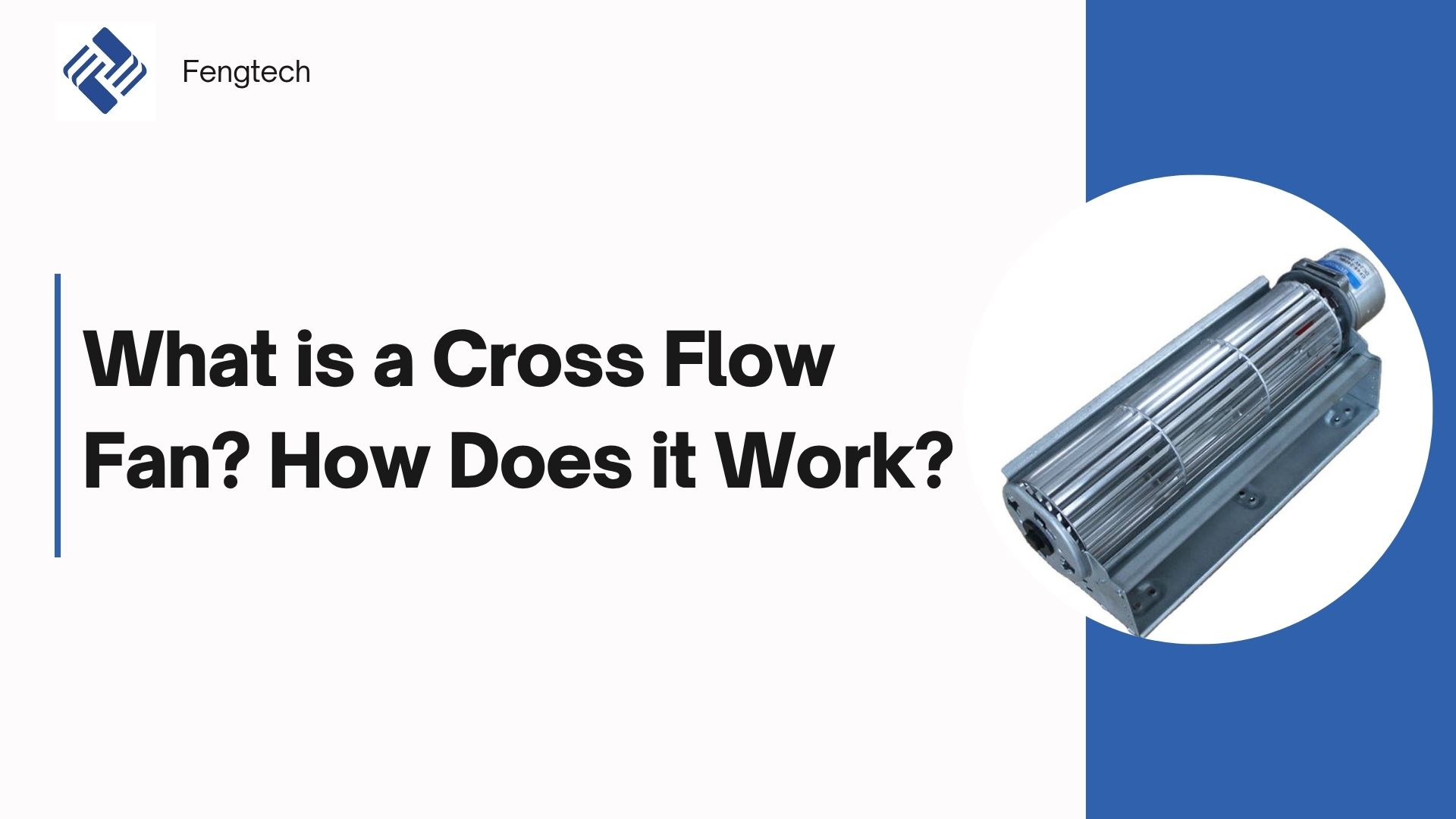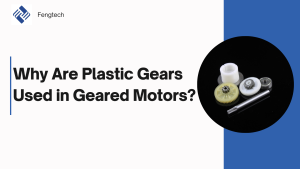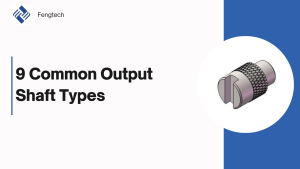Crossflow fans are also called tangential fans or “squirrel cage” fans. The working principle of crossflow fans is different from traditional axial flow fans or centrifugal fans. It focuses on producing wide and uniform airflow over a large area. This article mainly introduces the working principle, advantages and disadvantages, application range, and difference between crossflow fans and centrifugal fans.
1. How Does a Cross Flow Fan Work?

The working principle of a cross-flow fan is easy to understand. It can be imagined as a widened windmill that accelerates the airflow from one end to the other.
When the impeller rotates:
1. Air enters radially into the impeller across its entire length.
2. Inside the impeller, the air follows a spiral (vortex) path, driven by centrifugal force.
3. The guide vane redirects part of this internal vortex, stabilizing and accelerating the flow.
4. The air is then discharged tangentially and evenly along the length of the outlet.
5. Unlike axial or centrifugal fans, the air path in a cross flow fan is transverse, forming a nearly laminar sheet of airflow, which is useful in applications requiring uniform ventilation over a broad area.
2.The Structure of a Cross Flow Fan
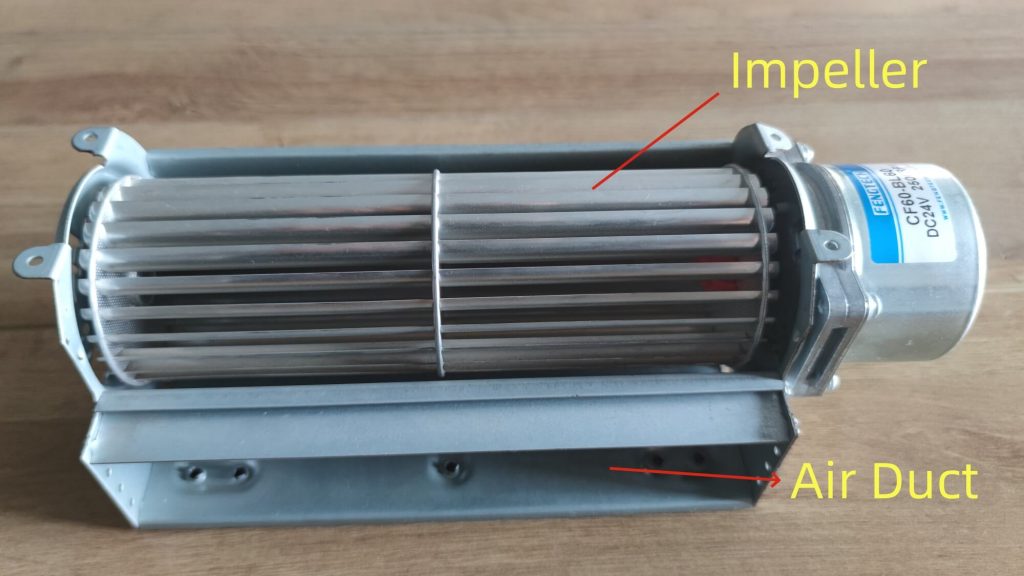
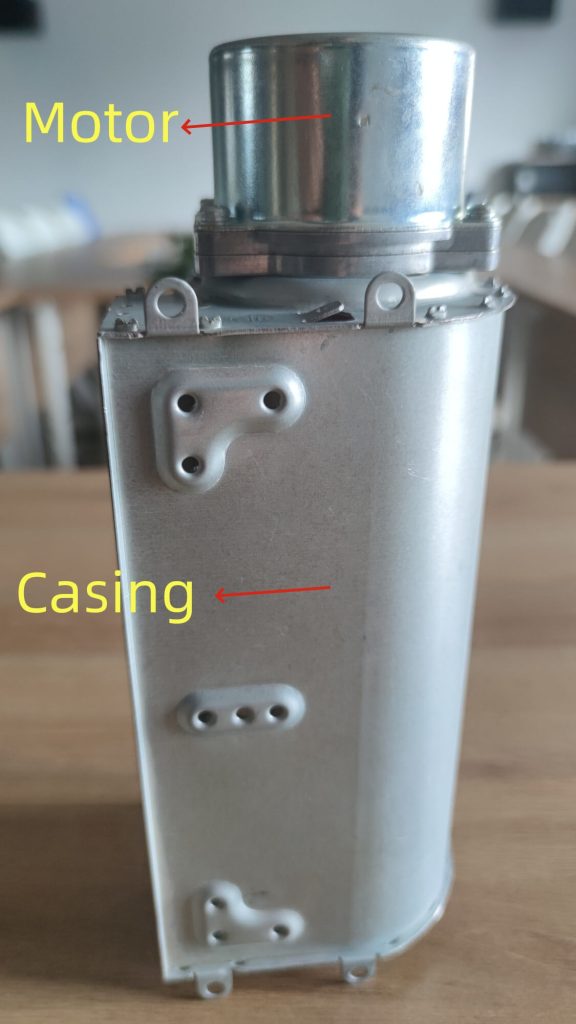
The cross-flow fan is mainly composed of five parts: impeller, casing, motor, bearing, and air duct. The following are the design methods and functions of each component:
1.Impeller
Shape: The impeller is a key component of a cross-flow fan and is usually designed in the shape of a long cylindrical drum. The impeller is surrounded by many thin forward-curved blades. These blades are usually tilted at a certain angle, usually 30-60 degrees relative to the impeller axis, to optimize the airflow direction.
Material: The material of the impeller is usually aluminum alloy. Aluminum alloy impellers have the advantages of high strength, light weight, high temperature resistance, etc., and can maintain stable operation without deformation.
2.Casing
The casing is a fixed arc-shaped housing that partially encloses the impeller. It is usually cylindrical or scroll-shaped and is designed with an air inlet and an air outlet. The casing guides the air entering from the air inlet to the impeller and then guides the air discharged from the impeller to the air outlet. It also helps to adjust the airflow shape to make it more uniform and helps reduce noise.
3.Motor
Installation location: The drive motor is usually installed at the end of the drum, outside the airflow, and connected to the impeller through a shaft. This installation method can avoid the influence of the motor on the airflow and ensure the stability of the airflow.
Select type: Different types of motors can be selected according to application requirements. The motor provides power to drive the impeller to rotate, and its speed and power determine the speed and air volume of the impeller.
4.Bearing
Function: Bearings are used to support the rotation of the impeller shaft, reduce friction between moving parts, and ensure smooth rotation of the impeller. This helps improve fan efficiency, reduce energy consumption, and extend fan life.
Installation location: Bearings are usually installed at both ends of the impeller shaft, in contact with the housing or supporting structure to provide stable support and reduce vibration and noise.
5.Air Duct
Shape and design: Ducts are usually stamped from sheet metal and are designed to connect the fan’s air inlet and outlet to the external air circulation system. Their shape and size are determined by specific application requirements. Ducts guide airflow in and out of the fan and can regulate air volume and pressure.
3. Advantages and Disadvantages of a Cross Flow Fan
| Advantages | Disadvantages |
|---|---|
| Uniform airflow distribution across the outlet | Lower static pressure compared to centrifugal fans |
| Compact and slim design suitable for narrow spaces | Not efficient for high airflow volume applications |
| Quiet operation with low vibration | Requires precise housing for optimal performance |
| Produces a stable, laminar airflow ideal for air curtains | Higher cost in some industrial applications |
| Some models allow reversible airflow | Maintenance can be difficult in enclosed systems |
4. Applications of Cross Flow Fans
Cross flow fans are widely used in industry and life. The following are the equipment or industries of cross flow fans:
Air Curtains
HVAC Systems
Ventilation Units
Electronics Cooling
Rack Servers/Enclosures
Industrial Control Cabinets
Convection Ovens
Clothes Dryers
Dehumidifiers & Air Purifiers:
Some Air Conditioners
Refrigerators/Freezers
Treadmills/Ellipticals
Material Dryers
Refrigeration Units
Display Cases (Refrigerated/Freezer)
Vending Machine Cooling
HVAC Systems
Seat Ventilation
5.Cross Flow Fans vs Centrifugal Fans
| Feature | Cross Flow Fan | Centrifugal Fan |
|---|---|---|
| Airflow Direction | Air flows across the fan, perpendicular to the axis | Air enters axially and exits radially |
| Airflow Pattern | Wide, uniform airflow along the length | Concentrated, high-pressure airflow |
| Design Shape | Long cylindrical impeller | Drum-shaped impeller with radial blades |
| Pressure Output | Low static pressure | High static pressure |
| Noise Level | Generally quieter | Moderate to loud, depending on speed |
| Size & Form Factor | Compact and flat; suitable for narrow spaces | Bulkier; requires more installation space |
| Common Applications | Air conditioners, air curtains, electronics cooling | Industrial ventilation, HVAC duct systems, blowers |
| Efficiency | Efficient for low airflow applications | Efficient at high airflow and pressure applications |
| Cost | Usually less expensive | Generally higher due to robust design |
Fengtech's Cross Flow Fan Display:
Voltage: 12V/24V Cross Flow Fan
Input power: 20-60W
Speed: 0~2800RPM
Output power: 12~45W
Direction: Bidirectional rotation
Using temperature: -40-65℃, humidity <85%
Certification: CE, CCC, ROHS
With impedance protection and temperature protection
Cross Flow Fan Design:
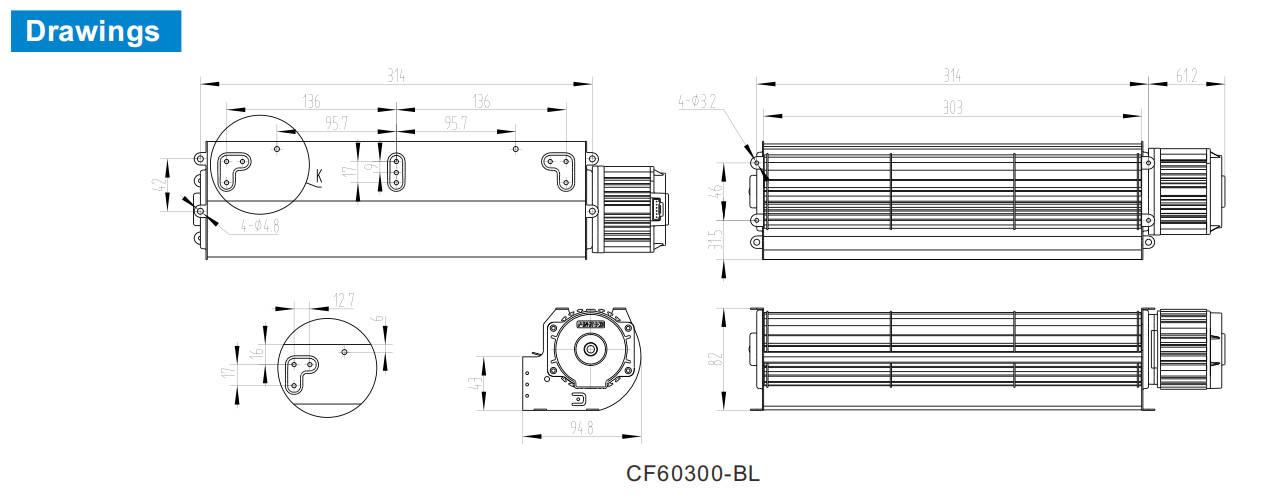
Summarize
The above is some basic information about cross flow fans. If you are purchasing cross flow fans, or are working on related projects, please contact the fengtech team. We are located in Ningbo, China, and have more than ten years of experience in motor research and development. No matter what equipment you use it for, we can provide corresponding solutions.

